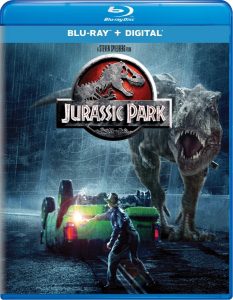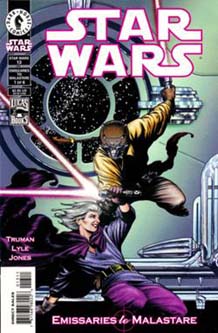The third and fourth arcs of “Star Wars: Republic” — “Emissaries to Malastare” (1999-2000) and “Twilight” (2000) – continue the trend of one mediocre arc followed by one great arc. Despite being written by Tim Truman, author of the excellent “Outlander,” “Emissaries to Malastare” is a confusingly plotted hodgepodge.
Even though I read it within the last week, I can’t recount the exact nature of the conflict the Jedi are dispatched to mediate on Malastare. Truman doesn’t seem all that invested in it himself, as the plot is wrapped up after four issues, leaving a strange two-issue add-on of Mace Windu and Depa Billaba investigating the smuggling of akk dogs from Mace’s home planet of Haruun Kal to the underground fighting rings of Nar Shaddaa. (But I can’t be totally dismissive of that thread, as it’s a nice lead-in to Matthew Stover’s Mace Windu novel “Shatterpoint,” which I recall as being pretty good.)
It seems that Truman really wanted to play with the 12 Jedi Council members. Perhaps recognizing the absurdity of having all dozen of them go on one mission, he only sends half of them to Malastare. (For trivia buffs, the 12 “Episode I” Jedi Council members are Yoda, Mace Windu, Yaddle, Saesee Tiin, Ki-Adi-Mundi, Oppo Rancisis, Adi Gallia, Even Piell, Eeth Koth, Yarael Poof, Plo Koon and Depa Billaba.)
Still, this arc — along with “Jedi Council: Acts of War” (which was published later in 2000, and which also sees a good chunk of the council embarking on a single mission) — seems to put a lie to the notion that there are 10,000 Jedi Knights in the galaxy, as asserted in the “Episode I” novelization. If there are that many Knights, why would the Council members ever have do anything more than be managers? I’m not sure the number of Jedis in the galaxy was ever totally resolved throughout the prequel comics, novels and TV series, but it seems the Council tended to advise from on high rather than going into the field themselves, leaving “Malastare” and “Jedi Council” as exceptions to the rule.
Truman continues to be a better character writer than plotter, and in “Malastare” we meet the Dark Woman, whose style of training for A’Sharad Hett pushes uncomfortably close to the dark side. To use football terminology, if Qui-Gon Jinn is a players’ coach, the Dark Woman is the type of coach who locks players in equipment sheds. It’s no wonder Aurra Sing doesn’t care for her former teacher – but more on that in a future arc.
Truman is also a good team player in terms of continuity. In “Republic’s” first use of a main “Episode I” character, in Issue 13 Anakin shoots the breeze with Tusken Raider/Jedi Padawan A’Sharad about the podraces on Malastare. (“I always thought Tuskens looked nasty. But he’s not. He’s nice,” Anakin tells Ki-Adi-Mundi.) We also see Sebulba flying Anakin’s podracer, which he had purchased from Qui-Gon in the “Episode I Adventures” comics. And Truman gives cameos to Villie and Quinlan Vos, the stars of the next arc.


John Ostrander, one of the best (and certainly one of the most prolific) “Star Wars” comic writers, makes a spectacular debut with “Twilight.” The wickedly grinning Devaronian Vilmarh Grahrk (Villie) is one of the most strangely endearing characters Dark Horse ever produced. Every decision he makes is based on money. If he has a bet that Quinlan will not get off a planet alive, he’ll try to kill him. If he has a bet that Quinlan will survive, there’s no better ally than Villie. He talks in an almost Jar Jar-esque childlike fashion, saying “quick-quick” and “yum-yums” (attractive females), but he’s street smart.
Quinlan Vos, meanwhile, makes for a fascinating way to approach the light-side/dark-side conflict that was generally yawn-worthy even by 2000. When we meet him, he has amnesia. However, he also has the ability to glean images from objects, so by touching two lightsabers, he realizes he is a Jedi Knight and his Padawan is the Twi’lek Aayla Secura. (Some fans feel that giving Jedi such specific powers pushes them a little too far into “X-Men” territory, but I’ll allow it here – although, admittedly, the Dark Woman’s ability to teleport [!] seems a bit over-the-top.) Because Quinlan does not remember the Jedi code, he’s prone to tiptoe into the dark side as he seeks his answers. It makes for great scenes where Quinlan’s adversaries are stunned by his behavior, like this one from Issue 20:
Bib Fortuna (defeated and gasping): “Jedi … do not kill! Jedi code!”
Quinlan Vos (furious): “I know no code! I do not know what Jedi do! All that was taken from me when my memory was wiped! I only know that you are involved! I hold you responsible for what happened to me! Tell me!”
Still, when Mace Windu puts him on the spot at the end of “Twilight,” Quinlan acknowledges that he does answer to his inner morality, and he won’t kill Mace in order to kill the bad guy of the piece rather than see him go to trial for his crimes. This is a nice contrast to “Episode III,” where Windu puts himself between a different fallen Jedi and a different bad guy. That situation turns out a bit differently.
“Twilight” gets its name from its principal location of Ryloth, where the only habitable areas are the caves between the perpetually hot bright side and the perpetually cold night side. The “Young Jedi Knights” novels, of all things, also did a good job portraying the cave structure and badlands beyond. Unfortunately, “The Clone Wars” didn’t embrace this neat environmental concept when it visited the planet, and apparently it is the stuff of “Legends” now, along with the superior “Legends” portrayal of Mandalore.
After two years and 22 issues, “Republic” hasn’t coalesced into a truly ongoing series, but it has introduced a bevy of great characters – A’Sharad, Aurra Sing, the Dark Woman, Villie, Quinlan Vos, Aayla Secura – whom I want to learn more about.

